Menu

Winter forage crops help keep livestock fed for up to 5 months in places like the Gulf Coast states. This is amazing, even in areas known for their mild winters. Grazing is not just the best way to feed animals, but it’s also cheaper. By choosing the right forage and managing it well, farmers can make more money.
The Gulf Coast states often face unpredictable winter pasture. This is due to droughts despite their mild winters. Luckily, plants like annual ryegrass, small grains, and clovers can make up for this. They offer top-notch grazing, ensuring livestock have enough to eat during the winter.
Many things can influence the amount and quality of winter forage. Things like temperature changes, how many seeds are planted, and the type of fertilisation used are key. Brassicas – plants like kale and turnips – are great for making the grazing season longer. Chicory, on the other hand, doesn’t grow much in winter. But, it can still be good for grazing in late autumn or early spring.
It’s vital to know the different ways that winter forage crops grow. Testing soil to see if it’s fertile enough and adjusting its pH is very important. These steps help make sure the grazing system you set up is both productive and lasting.
Winter forage crops are key for keeping livestock healthy in cold months and boosting farm profits. They grow well when it’s chilly, so animals get the nutrients they need even when usual pastures are bare. Knowing how to use winter forages well is important for any farm.
Winter forage crops add up to a reliable source of food for animals. They keep up the same quality and amount of food all season, keeping the farm working smoothly. Thanks to new types of ryegrass, farms can now feed animals well for several winters in a row.
Plants like cereals and ryegrasses are strong choices for more feed in winter. Heritage Seeds offers many types of clovers, vetches, and chicory, which improve the feed’s quality. This variety helps farms choose the best plants for their region’s winter rain patterns.
Feeding animals in winter needs careful planning. Testing the soil, picking the right plants, and doing things at the right time are very important for success. Keeping good records of which fields get what, helps farmers know when to plant new winter crops.
The Brassica and Summer Forage Guide help pick the best plants for different farm goals. Choosing the right forage plants can really help animals grow strong and healthy in winter. With the best information and resources, we can improve how our farms work and keep animals well through winter.
In short, winter forage crops are crucial for farming through the colder months. With the right choice and care of forage plants, we make sure animals have enough to eat. This way, farms can be both productive and sustainable, even in winter.
Sustainable forage crops are key for soil health and nutrition. They need fewer external resources but improve farm output. Thinking about the environment, soil, and money helps create a strong farming system.
Forage crops that are sustainable help the environment. They increase plant and animal variety and cut down on harmful gases. Using a mix of plants is better than just one kind, as seen in trials. This attracts more birds, worms, and insects, which is good for the farm.

Mixed forages include a variety of plants. There’s Grass, Legume, Forb, Brassica, and Herb. Plants like Hairy Vetch fix nitrogen, which processes nutrients and reduces the need for extra fertilisers.
Good forage management improves how the soil looks and works. Plants like Daikon Tillage Radish break up hard soil, helping roots and water get in. Well-managed forages stop soil washing away and make it healthier, which is crucial for farming without hurting the land.
The management of materials like these boosts the life in soil. This helps the soil stay fertile without needing to buy lots of additives. This is good for the farm’s budget over time.
Sustainable forage is great for saving money. A mix of plants cuts down on feeding costs, making sure animals get what they need all year. It also means spending less on things to grow more crops.
Studies show making more money from these methods. For example, a 25.7% of Attila Ryegrass and 28.6% of C2 Canyon Oats in the mix are very profitable. Such productivity is a big help for keeping the farm’s finances strong.
Some of the specific challenges include the need for more winter-hardy species and optimal timing of grazing. However, the overall objective of improved soil health and economic sustainability is evident.
To sum up, sustainable forage plays a big role in keeping the soil, plants, and farm money healthy. A well-chosen mix of plants means better farming. It keeps the land doing well, food rich in nutrients, and the farm’s finances in check.
Choosing the right cool-season grasses is key for winter grazing success. They offer high-quality forage and keep livestock productive when it’s cold.
Annual ryegrass is great for its quick start and high yield. It does well in most soils but needs good drainage. Seeding it before the first frost ensures you have feed all winter.
To make it grow best, add nitrogen. Use 50 to 60 pounds per acre twice. Start in mid-January then again six weeks later for best results.
Wheat, rye, and barley are other good options for winter feed. Their seeding rates are 90 to 120 pounds per acre. They make a lot of feed for the winter.
Rye is best for tough winters. Wheat is good for both food and feed. Barley copes well with weak soils. Using nitrogen wisely will help them grow better.
It’s key to pick the right legumes for winter grazing to ensure both sustainable and nutrient-rich forage for animals. Crimson clover, white clover, and red clover are top choices. They bring unique qualities and benefits to the table.
Crimson clover shines for winter grazing, thanks to its strong germination and nitrogen-fixing skills. It serves as both a winter and summer annual legume, helping build soil, prevent erosion, and cover the ground between rows. Also, it mixes well with crops like rye and vetches, making it versatile for winter grazing setups.
One downside is that it’s not the best with drought, so it needs careful attention.
White clover is loved for how well it adapts, especially to wet areas. This makes it a great choice for many climates and soil types. It’s great for grazing, adds nitrogen to the soil, and keeps the soil healthy. Plus, it’s tough and can grow even in tough spots, giving a dependable forage for winter grazing.
Known by the name Trifolium pratense, red clover is praised for being a hard worker. It’s not just a nitrogen fixer; it’s also good at building soil, fighting weeds, and providing feed. It can last for some years and is strong when just starting to grow.
If you mix it with other plants like barley or corn, it becomes even more useful. And, it’s okay with grazing, which helps keep animals fed in winter.
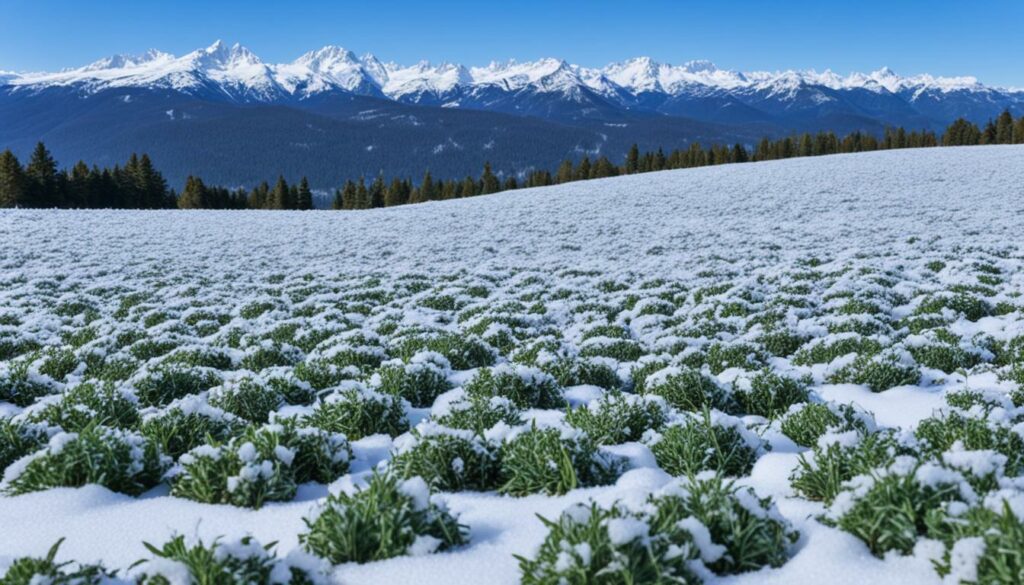
Brassicas are great for feeding livestock during winter. They include *kale*, *forage rape*, *turnips*, and *swedes*. Mixing them can improve the food’s quality for animals when cold. Each type adds special nutrients for winter.”
Kale grows well in the cold, perfect for the north. Farms can harvest about 12,000 lbs. from each acre. Animals like its leaves and stems which offer up to 25% protein and easy to digest. This helps them get lots of nutrients from it.”
Forage rape is also good, with a quick growing season. It gives about 8,000 lbs. of dry matter per acre. Its protein and digestibility levels match kale’s quality. Animals can start eating it after just 60 days of planting.”
Turnips are known for the big amount of food they make and can adapt well. Farmers can get up to 7,000 lbs. of dry food from one acre. They can start to be grazed 60 to 70 days after planting. The roots contain 10% to 14% protein and are 80% to 85% digestible. Yet, they can get infections, so they might need hay too.”
Swedes are less used but very nutritious for livestock. In about 150 to 180 days, they are ready to be grazed. Their protein content is good for animal health.”
| Brassica | Dry Matter Yield (lbs./A) | Grazing Readiness (Days) | Protein Content (%) | Digestibility (%) |
|---|---|---|---|---|
| Kale | 12,000 | 60 | 17-25 | 65-80 |
| Forage Rape | 8,000 | 60 | 17-25 | 65-80 |
| Turnips | 7,000 | 60-70 | 10-14 (roots) | 80-85 (roots) |
| Swedes | N/A | 150-180 | 10-14 (roots) | 80-85 (roots) |
Using brassicas like *kale*, *forage rape*, *turnips*, and *swedes* brings many benefits. It helps livestock get the nutrients they need in winter. With proper care and the right supplements, these crops make winter feeding much better.”
Chicory is active in late-fall and early spring but doesn’t grow much in winter. This is because it doesn’t like the cold. It’s not the best for winter feeding in some places. Still, it’s a good choice for some nutrients.
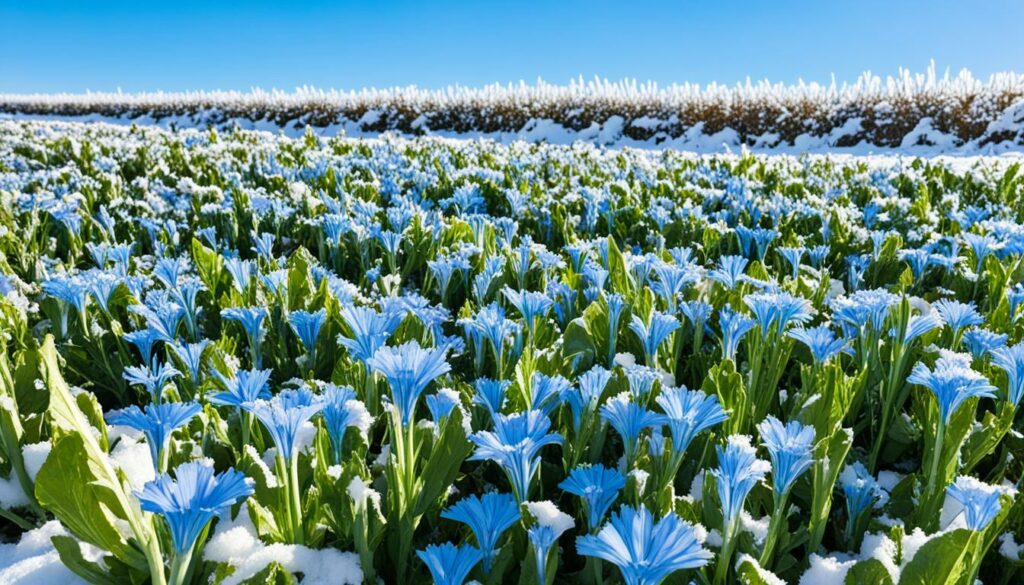
It likes well-drained soils and does well with some cool-season plants. These plants help the soil by adding nitrogen. Together, they make a strong mix. But, they need good soil to do their best.
Here’s a table showing Chicory’s minerals and how rich it is:
| Mineral | Content |
|---|---|
| Zinc | 66–117 ppm |
| Copper | 13 ppm |
| Manganese | 210–400 ppm |
| Iron | 300 ppm |
| Magnesium | 0.28–0.44% |
| Sulphur | 0.5% |
| Phosphorus | 0.3–0.5% |
| Calcium | 0.9–1.3% |
| Potassium | 2.6–6.9% |
Chicory is really tasty and helps animals grow well. It also fights off weeds. But, it needs good care in winter and a lot of nitrogen to stay healthy.
There are many types of Chicory. They all have different strengths. Choosing the right one is key for good winter crops. It depends on your farm and what it needs.
Proper soil testing and fertilisation are key for good forage growth and farming success. Test the soil to find out its nutrients and pH level. This helps plan how to fertilise the land. For best results, farmers should test their soil every 2 to 3 years, especially in late October to December. This keeps hay meadows and pastures productive.
Controlling soil pH boosts forage crops. Forage crops like a pH between 5.8 and 6.5. If the soil needs it, add lime by the end of January or early February. This way, the soil is ready for the growing season. If the pH is around 7.0 when you plant, you may not need to add lime for three years.
Forage growth needs nitrogen, phosphorus, and potassium. Legumes bring their own nitrogen when properly grown. This lowers the need for nitrogen fertiliser. Common legumes can take 50 to 60 pounds of nitrogen out of the soil for every ton of hay. But, grasses need added nitrogen, about 50 pounds per acre. For managed grass hay, a good nitrogen plan includes 100 lb/acre in spring, 50 lb/acre in summer, and 75 lb/acre in fall, totalling 225 lb/acre a year.
The time and way you fertilise are crucial for good forage. Use a winter pasture mix on bermudagrass from March to April. The growth of bermudagrass might be delayed until May in cooler springs. So, plan your fertilising carefully. After using winter forage, fertilising can help the bermudagrass grow more. Manure should be spread taking into account the season and rainfall. This affects how much nitrogen the soil can use.
By focusing on accurate soil testing, pH management, and timely application of essential nutrients, forage producers can greatly enhance crop yields and maintain soil fertility for long-term agricultural success.
Choosing the right planting methods is key to winter forage crop success. Techniques like no-till, broadcasting, and drill seeding make a big difference. They help seeds grow well, keep soil healthy, and maximise crop harvest.
No-till farming protects soil structure and cuts down erosion. It works great for brassicas. Not touching the soil keeps moisture in and helps good bugs thrive. This is perfect for places that face erosion a lot or have very hard soil.
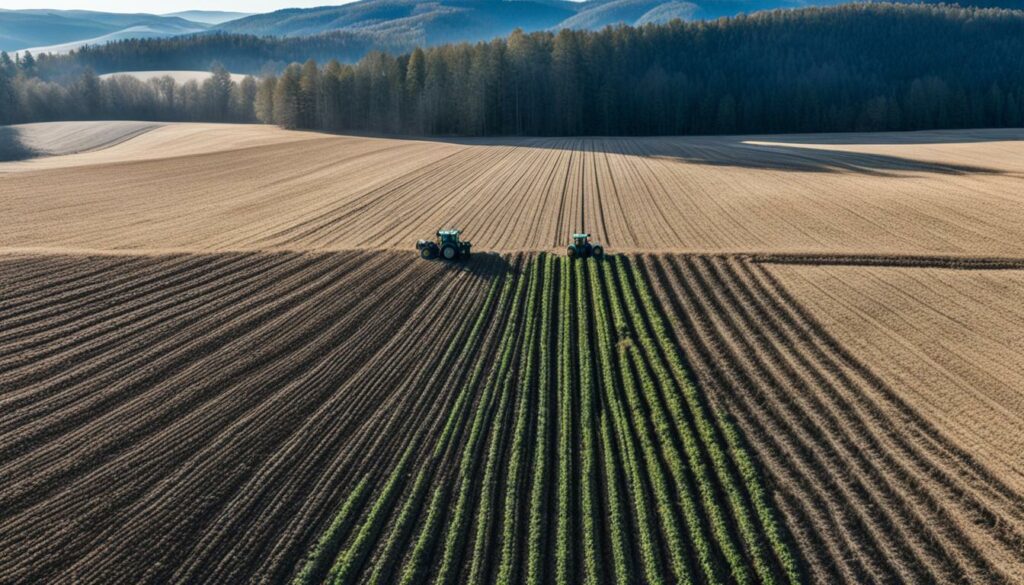
Throwing seeds by hand or using a spreader is called broadcasting. It’s common for planting ryegrass and other grains. Although it spreads seeds fast, not all seeds may grow well because they land unevenly. Yet, it’s a good choice for quick cover crops or short-term forage thanks to how easy and fast it is.
Drill seeding places seeds at the same depth, which helps them grow evenly. This is perfect for small grains and clovers. It gets the seeds right into the soil, ensuring a good start for the plants. Winter crops that need to be planted at specific depths, like brassica and chicory, benefit a lot from this.
Knowing these methods helps farmers pick what’s best for their needs. Each approach is suited for different plants, soil types, and weather conditions. The right choice can make winter forage crops more productive and earth-friendly.
| Planting Method | Advantages | Disadvantages | Best For |
|---|---|---|---|
| No-Till Planting | Improves soil structure, reduces erosion | May require specific equipment | Brassicas |
| Seed Broadcasting | Quick and easy, covers large areas | Variable germination rates | Ryegrass, Small Grains |
| Drill Seeding | Uniform seedling depth, better establishment | More time-consuming | Small Grains, Clovers |
Winter comes with unique chances for the Gulf Coast. Its mild climate is perfect for livestock and nutrient-rich forages. With careful management, these areas can feed livestock for almost five months.
Annual ryegrass stands out due to its early growth. It provides a steady source of forage from November to December. Wheat, rye, and barley are also good options. Each has its own planting requirements. These crops help keep animals well-fed.
Choosing the right forages is key for growth and health. Forage types like arrowleaf and crimson clover need specific planting dates and conditions. Brassicas like kale and turnips offer great forage in the early winter and spring. They add to the nutrient mix.
Soil health is critical for successful winter forages. A soil test six months before planting is a must. If needed, lime should be added to adjust pH levels. Adding up to 50 pounds of nitrogen per acre can help legumes grow early. It’s important to time and apply fertiliser correctly to not affect forage quality.
For the best results in the Gulf Coast, start with a soil test. This shows what nutrients the soil needs and if pH levels are right. The table below lists the best winter forages and how to plant them for success in the Gulf Coast.
| Forage Type | Optimal Planting Dates | Seeding Rates (lbs/acre) | pH Range | Growth Period |
|---|---|---|---|---|
| Annual Ryegrass | October – November | 25 – 30 | 5.5 – 7.5 | Nov – Dec |
| Wheat | October | 90-120 | 5.5 – 7.0 | Winter-Spring |
| Rye | September – October | 70 – 100 | 5.5 – 7.5 | Winter |
| Arrowleaf Clover | October | 8 – 10 | 6.0 – 7.0 | Spring |
| Crimson Clover | September – October | 20 – 30 | 5.5 – 7.0 | Late Winter – Spring |
| Kale | August – October | 3 – 5 | 6.0 – 7.0 | Early Winter – Spring |
| Turnips | August – October | 3 – 5 | 6.0 – 7.0 | Early Winter – Spring |
Winter grazing management is key for healthy pastures and efficient forage use. It’s best to use rotational or strip grazing. These keep forage even and boost pasture life and animal nutrition.
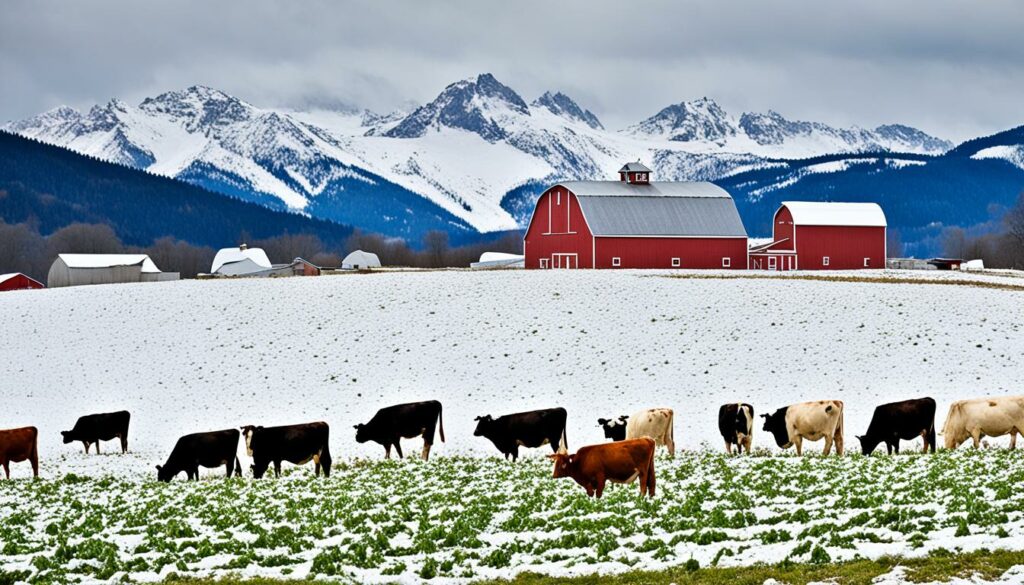
Rotational grazing separates the area into paddocks. Livestock move between these paddocks in an organised way. Each paddock gets time to recover, which avoids overgrazing and soil damage. It also helps animals digest nutrients better. Research shows this cuts phosphorus and sediment losses by 80-90%.
In strip grazing, animals are kept in a small area briefly, then moved to fresh ground. This method is great for using forage well, especially in winter when there might not be a lot. To protect waterways, keep at least a five-metre buffer. Strip grazing also stops soil damage and promotes soil health.
| Winter Grazing Management Practices | Benefits |
|---|---|
| Rotational Grazing Systems | Reduces overgrazing, prevents soil compaction, improves nutrient intake, reduces phosphorus and sediment losses |
| Strip Grazing Techniques | Maximises forage utilisation, maintains soil health, prevents pugging, reduces nutrient runoff |
Rotational and strip grazing are vital for winter grazing that’s both effective and eco-friendly. Adding buffer zones and fencing to protect waterways enhances these methods.
As winter comes, having high-yielding forage crops is critical for good winter grazing and supporting sustainable farming. We will look at top forage plants that provide plenty. They help keep animals fed in the cold months.
In the Gulf Coast states, the winters are mild. This lets farmers use a range of forage crops. Arrowleaf and berseem clovers, mixed with annual ryegrass or small grains, are popular. They grow well and support the local weather. This helps in farming sustainably.
Plants like kale, forage rape, turnips, and swedes are great for feeding animals in early winter and spring. They offer top-notch forage, making winter grazing more effective. Chicory is also used, but it grows less in winter. It’s good for grazing in late fall or early spring, showing it can handle tough times.
We’ll now explore what makes these forage plants special.
Making the most of these high-yielding forage crops needs careful planning. Think about how much to plant, the soil’s health, and what the crops need to grow. Using the right amount of nitrogen is key. It helps the plants grow strong. Doing all this supports sustainable farming and ensures good harvests in winter.
By planning well and putting these plans into action, farms can be more productive. Livestock can eat well through winter.
Cold-tolerant forage species are key for feeding livestock in winter, especially in the north. They keep growing and offer vital nutrients even when it’s cold. These crops differ but all help farmers in cold areas stay productive.
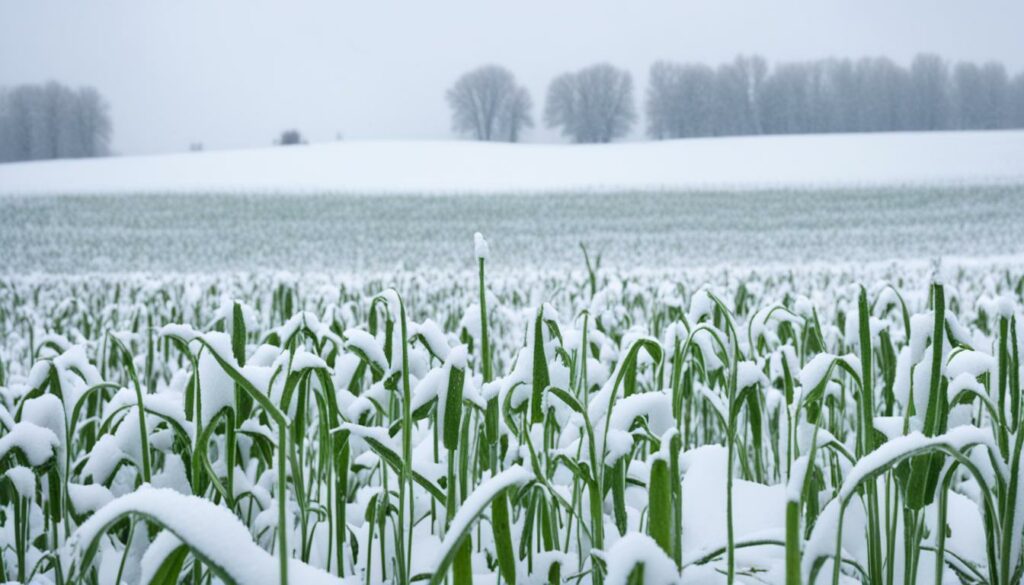
Cold-tolerant forage includes cereal rye, kale, and clovers. Rye is very hardy and provides a lot of food in late autumn and winter. This makes it essential for livestock in winter. Kale thrives in cold, letting animals graze longer into the autumn.
Winter-hardy crops like cereal rye and kale are essential for feeding livestock in winter. They continue to provide nutrients, keeping animals healthy and farms profitable. Adding winter forage to a farm’s nutrition plan is a smart move for northern areas.
“In South Texas, oats are recommended for planting in early fall due to their ability to produce the most early dry matter of cool-season forages.”
Clovers are great too; they thrive in cold and help the soil by adding nitrogen. This means even more food for animals and less need for extra fertiliser. Planting a mix of these crops leads to better farming and more food for animals in the north.
| Forage Crop | Cold Tolerance | Benefits |
|---|---|---|
| Rye | High | Produces significant winter forage |
| Kale | Very High | Extended grazing period; high nutritional value |
| Clovers | Moderate to High | Improves soil nitrogen; resilient growth |
Adding a mix of forage species to your grazing land can boost the health of the soil and your animals. A study with 16 different plants showed big benefits over growing just one type. This mix includes various grasses, legumes, forbs, brassicas, and herbs. Each plant type helps the whole system work better and last longer.
One main plus of varied forage is better soil health and more diverse life in the area. These mixed plants keep the ground covered all year. This stops the soil from washing away and keeps it healthy. It means water can soak in well, which is great for the ground.
Mixing things up can save you money too. Putting legumes in with the other plants means you don’t need as much extra nitrogen. Farmers in the study also found they didn’t need to buy as many animal feeds. This is because the mix of plants gives the animals all the nutrients they need. It helps them stay healthy without extra costs.
A four-farm study looked at different measures, like what the plants are good for, how the soil changes, and what it costs to run the farm. It found that diverse mixtures were better for the soil and the wildlife than just growing one type. Farmers, like Tom Armitage and George Greed, noticed their soil getting better and water soaking in more easily.
| Species | Percentage Composition (%) |
|---|---|
| Grass | 55.14 |
| Legume | 22.00 |
| Forb | 11.51 |
| Brassica | 10.15 |
| Herb | 1.20 |
What’s more, the study showed the importance of adding tough plants for colder months. It makes your grazing land better able to handle all sorts of weather. Growing a mix of plants is key for making winter grazing good for the animals and the pocket. It’s a smart move for anyone wanting their farm to be both successful and kind to the environment.
Managing winter forage crops well is crucial for good grazing and strong livestock health in the cold. It’s about picking the right plants, keeping the soil healthy, and grazing smartly. Mixing different plants like grasses, legumes, and brassicas makes forage better for animals and helps the soil deal with pests and diseases.
Forage crops like kale and fodder beet are cost-effective, producing a lot of feed per hectare. They show how important it is to find a good balance between cost and benefits. Plants like stubble turnips and swedes are rich in protein and energy, again, highlighting the need for a smart choice.
Managing the soil is key too. Before planting, testing the soil for pH and nutrients is a must to ensure the best growth. Keeping the soil slightly acidic, pH 5.8 to 6.5, is vital for plants to take up nutrients well. Knowing the soil preferences of plants, like alfalfa needing pH 6.9, can boost your harvest.
In the end, looking at the big picture – the environment, costs, and farming methods – helps create the best winter feeding plans. Good planning and using the right methods are the key to a successful and green winter grazing. This approach builds a strong and profitable farm for the long term.
For the winter, choosing the right crops is key for grazing. Look into annual ryegrass and small grains like wheat, rye, and barley. Don’t forget about clovers such as crimson, white, and red clover. Brassicas like kale, turnips, and swedes are also important.
Choose forage species that suit your local weather and soil. Look into annual ryegrass, small grains, and legumes. These keep going strong in winter and are full of nutrients for your animals.
Sustainable forage crops do a lot of good for the environment. They help soil, add to biodiversity, and cut down on greenhouse gases. These crops also use nutrients well and need less from outside sources.
Testing soil is vital for knowing what your crops need. It helps them grow well. Changing the soil’s pH with lime, based on these tests, makes nutrients easier to get to. This boosts the soil’s health.
For good winter grazing grasses, look at annual ryegrass. It’s known for being strong and good for eating. Also, small grains like wheat, rye, and barley each have their benefits for the winter.
Crimson clover, white clover, and red clover are great for winter. They add nitrogen to the soil and are good for grazing. Plus, they grow well and work in different soils.
Brassicas, like kale and swedes, give a lot of good forage. They’re great in autumn and early winter. And they’re tough against the cold, with lots of nutrition for your animals.
In the Gulf Coast, you pick crops that can handle the local weather and soil. Choose species like annual ryegrass, small grains, and annual clovers. They do well in these conditions, offering great grazing.
Rotational and strip grazing are good for several reasons. They make the most of forage, stop the land from getting too worn out, and help animals eat better. Also, they make your winter grazing plans last longer and work better.
Top winter forages include ryegrass, small grains, and brassicas. They make a lot of dry matter for your animals. These are key for keeping your farm running well and looking after the land.
For places with cold winters, choose forages like cereal rye and kale. There are certain clovers that do well too. They make sure your animals get the food they need, even when it’s cold out.
Mixing different forages does a lot for your land and animals. It boost soil quality, keeps pests away, and adds nutrients. Your animals also get a more balanced diet, which they enjoy eating.